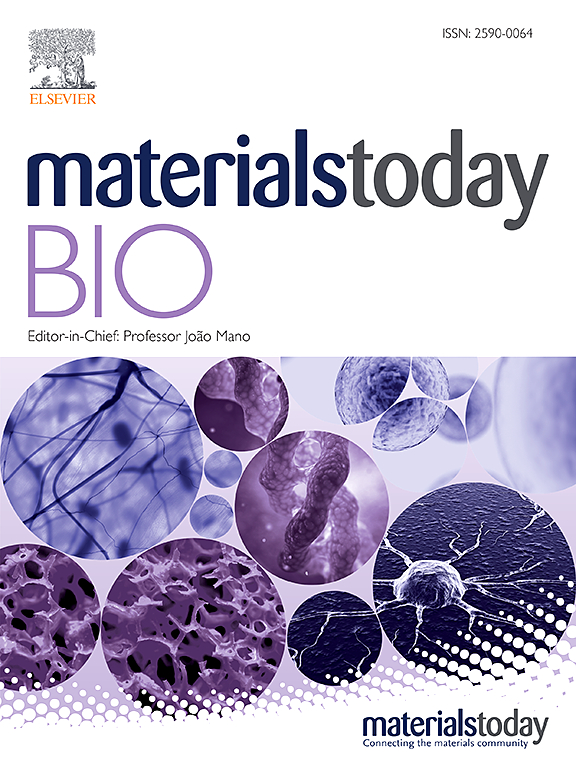三维打印β-TCP支架作为骨肉瘤工程模型的仿骨环境:体外特性和转录组学研究
IF 8.7
1区 医学
Q1 ENGINEERING, BIOMEDICAL
引用次数: 0
摘要
面对骨肉瘤研究的进步,现有的临床前模型-包括体外(即二维和三维细胞培养,类器官)和体内方法(即异种移植,动物模型)-往往具有低可翻译性的特点,限制了它们对临床结果的预测能力。本研究探讨了3d打印β-磷酸三钙(β-TCP)支架作为高级体外骨肉瘤临床前模型的骨模拟环境的潜在用途。评估了支架与骨肉瘤细胞球状体、内皮细胞和原代骨髓间充质干细胞(pBMSCs)的相容性及其理化特性。对支架上pBMSCs的转录组学分析显示,基因表达谱表明细胞外基质组织明显,成骨活性较小。该模型在三培养系统中有效地复制了肿瘤微环境的重要方面,动态灌注增强了代谢活性。采用所建立的支架模型进行阿霉素细胞毒性试验。与球形单培养相比,三联培养具有明显的多柔比星积累,这证明了它的生理意义。尽管所提出的方法在模型的有效血管化方面存在局限性,但本研究强调了3d打印β-TCP支架在肿瘤建模中的潜力,以支持生理学相关的临床前模型。本文章由计算机程序翻译,如有差异,请以英文原文为准。

3D-printed β-TCP scaffold as a bone-mimicking environment for an engineered model of osteosarcoma: In vitro properties and transcriptomic insights
In the face of advancements in osteosarcoma research, existing preclinical models – including in vitro (i.e., two- and three-dimensional cell cultures, organoids) and in vivo approaches (i.e., xenografts, animal models) – are often characterised by low translatability, limiting their predictive power for clinical outcomes. This study investigated the potential use of a 3D-printed β-tricalcium phosphate (β-TCP) scaffold as a bone-mimicking environment in an advanced in vitro osteosarcoma preclinical model. The compatibility of the scaffold with osteosarcoma cell spheroids, endothelial cells, and primary bone marrow-derived mesenchymal stem cells (pBMSCs) was evaluated along with its physicochemical characteristics. Transcriptomic analysis of pBMSCs on the scaffolds revealed gene expression profiles indicating pronounced extracellular matrix organisation and minor osteogenic activity. The model effectively replicated significant aspects of the tumour microenvironment in a tri-culture system, with dynamic perfusion enhancing metabolic activity. The developed scaffold-based model was employed in the doxorubicin cytotoxicity test. The physiological significance of the tri-culture was demonstrated by its distinct doxorubicin accumulation, in contrast to spheroid monocultures. Despite the limitations of the proposed approach regarding efficient vascularisation of the model, this study highlights the potential of 3D-printed β-TCP scaffolds in tumour modelling to support physiologically relevant preclinical models.
求助全文
通过发布文献求助,成功后即可免费获取论文全文。
去求助
来源期刊

Materials Today Bio
Multiple-
CiteScore
8.30
自引率
4.90%
发文量
303
审稿时长
30 days
期刊介绍:
Materials Today Bio is a multidisciplinary journal that specializes in the intersection between biology and materials science, chemistry, physics, engineering, and medicine. It covers various aspects such as the design and assembly of new structures, their interaction with biological systems, functionalization, bioimaging, therapies, and diagnostics in healthcare. The journal aims to showcase the most significant advancements and discoveries in this field. As part of the Materials Today family, Materials Today Bio provides rigorous peer review, quick decision-making, and high visibility for authors. It is indexed in Scopus, PubMed Central, Emerging Sources, Citation Index (ESCI), and Directory of Open Access Journals (DOAJ).
 求助内容:
求助内容: 应助结果提醒方式:
应助结果提醒方式:


